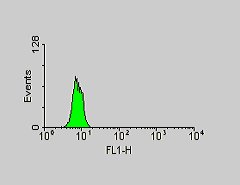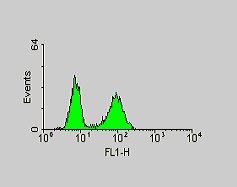Product
제품
- Apo Active 3 FITC
- 제품명: Apo Active 3 FITC
- 용도: Antibody Specific Active Caspase 3 Detection Kit
- 메이커: Cell Technology
- 카달로그:
소개
Apo Active 3 FITC
Antibody Specific Active Caspase 3 Detection Kit
1. Key Benefits
• Highly specific for active human and murine caspase 3. Other assays require the utilization of peptide based (DEVD) reagents
that tend to cross-react with caspase 7 and other caspases
• Applications – Works with a fluoresence microscope, 96 well plate reader, or flow cytometer
• Yields both quantitative and qualitative results. Gives a strong positive signal
• Can be used in conjunction with other antibodies or stains
• No need to make cell lysates or run western blots. Cells can be fixed and analyzed later
• Works with human, mouse and rat cell lines
2. Assay Principle
Cell Technology ’s APO-ACTIVE CASPASE 3 Kit utilizes a rabbit affinity purified polyclonal antibody raised against amino acid 163-175 of murine caspase 3 (9). This neo epitope is present on the p18 subunit of cleaved caspase 3 (9). Cells undergoing apoptosis are fixed and permeablized prior to the addition of the antibody. A secondary FITC labeled goat anti rabbit antibody is used to visualize the bound rabbit anti caspase 3 polyclonal.

Fig (A). Jurkat Cells were stimulated with DMSO for 2 hours. The cells were washed and fixed for 15 minutes. The cells were then permeabilized with saponin and stained with Rabbit anti active caspase 3 antibody for 1 hour. The samples were then stained with PE labeled Goat anti Rabbit antibody.

Fig (B). Jurkat Cells were stimulated with staurosporine for 2 hours. The cells were washed and fixed for 15 minutes. The cells were then permeabilized with saponin and stained with Rabbit anti active caspase 3 antibody for 1 hour. The samples were then stained with FITC labeled Goat anti Rabbit antibody.
주문정보
|
Reagent |
Part# |
Temperature |
|
Rabbit Anti Cleaved Caspase 3 Affinity Purified Polyclonal Antibody, 1 Vial |
Part # 1002 |
2-8°C |
|
FITC Labeled Goat Anti Rabbit Affinity Purified Polyclonal Antibody, 1 Vial |
Part # 2002 |
2-8°C |
|
10X Fixative, 1 Vial |
Part # 3001 |
2-8°C |
관련자료
Reference
The endoplasmic reticulum is the site of cholestrol-induced cytotoxicity in macrophages - Feng, Yao, Li, Devlin et al - Nature Cell Biology Vol 5, No 9 September 2003, pp 781-792
Combination chemotherapy with gemcitabine and biotherapy with opioid growth factor (OGF) enhances the growth inhibition of pancreatic adenocarcinoma - Ian S. Zagon, Jeffrey R. Jaglowski, et.al. - - Cancer Chemotherapy and Pharmacology Vol 56/ No 5, Nov 2005
The Pseudomonas aeruginosa type III secreted toxin ExoT is necessary and sufficient to induce apoptosis in epithelial cells - Sasha H. Shafikhani, Christina Morales and Joanne Engel - Cellular Microbiology Vol 10 Issue 4, pp 994-1007, Dec 2007
Monoclonal Anti–Interleukin 23 Reverses Active Colitis in a T Cell–Mediated Model in Mice - C. Elson, Y. Cong, C. Weaver, T. Schoeb, T. McClanahan, R. Fick, R. Kastelein - Gastroenterology Volume 132, Issue 7, Pages 2359-2370 (2007)
Acute and chronic microvascular alterations in a mouse model of ischemic acute kidney injury - Markus Horbelt, So-Young Lee, Henry E Mang, Nicole L. Knipe, Yoshikazu Sado, Andreas Kribben, and Timothy A Sutton - Am J Physiol Renal Physiol July 11, 2007
Cytotoxicity and Secretion of Gamma Interferon Are Carried Out by Distinct CD8 T Cells during Mycobacterium tuberculosis Infection - Thorbjorg Einarsdottir, Euan Lockhart, and JoAnne L. Flynn - American Society for Microbiology - Infection and Immunity October 2009, p. 4621-4630, Vol. 77, No. 10.
Converting cell lines representing hematological malignancies from glucocorticoid-resistant to glucocorticoid-sensitive: Signaling pathway interactions - Anna S. Garza, Aaron L. Miller, Betty H. Johnson, E. Brad Thompson - Leukemia Research Vol Vol 33, Issue 5, pp 717-727. May 2009
